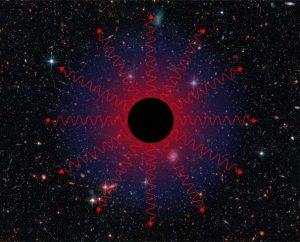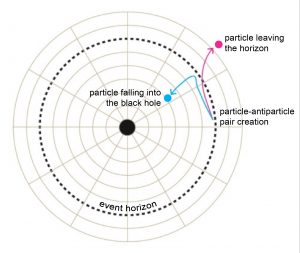
Every year, the prestigious American Physical Society (APS) issues a list of the most important articles published in the journals the APS is an editor for. For 2016, as one would expect, it was the gravitational waves discovery by the LIGO interferometer that prevailed. Other articles were chosen since, according to the APS editors, they described “research that marked a change in perspective, demonstrated an impressive experimental feat, or simply made us think”.
Scrolling down the list, the third place is occupied by an article by Stephen Hawking, Malcom Perry e Andrew Strominger, about the so-called black holes “information problem”, pubblished in June 2016 on the Physical Review Letters. In order to understand what this is about, we ought to make a brief summary of the most important results achieved in the study of these intriguing monsters in the sky.
While the term ‘black hole’ appeared for the first time in an article by John Wheeler (and what a painful paternity: the term was considered obscene by the journal’s editor, who initially rejected the article for this reason), it was John Michell and Pierre Laplace, back in the XVIII century, who first described a body with such a mass that the escape velocity from its gravitational field was higher than the speed of light.
Eintein’s General Relativity claims that a stationary black hole can be entirely defined by just three parameters: mass, electric charge and angular momentum. Wheeler summed this up saying “black holes have no hair” (picture the face of our previously mentioned editor when he received an article by Wheeler – yes, Wheeler again – in which he claimed that the hole was not only black, but also ‘hairless’). What Wheeler said has an important implication: whatever piece of information goes in the black hole is no longer visible from the outside. When a star collapses into a black hole, information such as shape and composition of the star are lost in the process.
The revolution in black hole physics happened in the mid-70s’ and it was triggered by two mind-blowing results. For the first result we should thank Jacob Bekenstein, who proved that the black hole’s entropy is proportional to its event horizon area (the surface inside which the information is hidden). But, where there is entropy, there is temperature. This intuition was confirmed in 1975 by Hawking who, studying the behavior of quantum fields near the horizon, proved that it emits an approximately thermal radiation – the Hawking radiation – in the same way a warm object emits heat. Hawking’s formula for the temperature of the radiation is regarded as the most important result achieved, linking Quantum Mechanics and General Relativity principles. Perhaps the first step towards the holy grail of contemporary physics: quantum gravity.

Therefore, black holes are not that black after all, and more importantly, if nothing falls into one them, the energy lost in this “Hawking radiation” will translate into a progressive reduction of the black hole’s mass, up to its complete evaporation. So what happens to all of the information stored inside the horizon? According to Hawking, it was lost: a conclusion today incompatible with quantum mechanics laws that claim information is never lost.
Come the 90s’, some developments in the string theory allowed a few theoretical physicists, such as the Nobel prize Gerard ‘t Hooft and Leonard Susskind, to challenge Hawking’s conclusion, starting the controversy that went down in history as “the black hole war”. (Details of this war are described in Susskind’s book). According to these theoretical physicists, every piece of information falling into the black hole will resurface when it evaporates, so Quantum Mechanic is safe. However, how this is supposed to happen is still not clear.
Hawking, Perry and Strominger added another piece to the puzzle of the information issue with an article claiming that the assumption of ‘hairless’ black holes might just be unjustified. Discussing quantum properties of an electromagnetic field near the horizon, they proved that it emitted an infinite number of photons with basically zero energy. These photons are the ‘soft hair’ of the black hole, and they get excited whenever a charged particle falls into the black hole.
This analysis was limited to the electromagnetic field and would need to be replicated for gravity. The authors are working on the issue and from the first calculations it seems that this result could be extended to the gravitational interaction. What is still unclear is whether all of the information is captured by this ‘hair’ growing from the black hole’s horizon.
Overall, this article offers no definite solution to the problem of information inside black holes. However, it certainly offers a promising direction to explore.
Read the full article. (Danilo Babusci)
 INFN-LNF Laboratori Nazionali di Frascati
INFN-LNF Laboratori Nazionali di Frascati